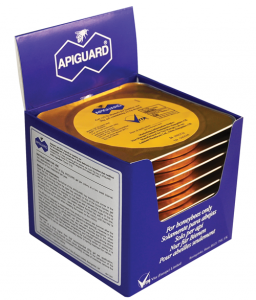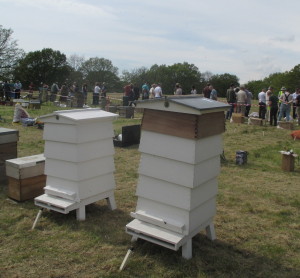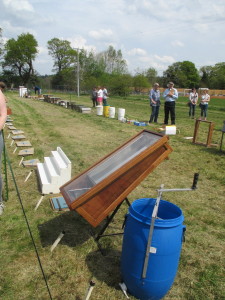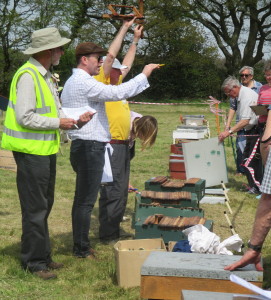Blog – bees, beekeeping & other sticky subjects
EFB Alarm Bells – tested
 I have been watching two colonies in two separate apiaries carefully this spring. Neither has been developing as quickly as others in the same apiary and have begun to show signs of gaps in the brood.
I have been watching two colonies in two separate apiaries carefully this spring. Neither has been developing as quickly as others in the same apiary and have begun to show signs of gaps in the brood.
I have been looking for the tell-tale signs of European Foulbrood (EFB) or even American Foulbrood (AFB).
Larvae infected with EFB appear twisted in their cells, sometimes forming an unnatural C-shape along the sides or in the bottoms of the cells. The infected larvae turn yellow and then brown eventually drying to rubbery scales within the cells.
Larvae infected with AFB die in the late larval stage with the body stretched out. As the dead larva decays, it eventually dries to a dark sticky “scale” which becomes gelatinous. If the cadaver is probed with a matchstick or something similar, the body can be “roped-out” – a key diagnostic symptom of AFB.
Neither colony showed these symptoms, but the symptoms were closer to EFB, so I used the Vita EFB test kit to see if it might show up positive.
The test, somewhat like a pregnancy test kit, is very easy to use. It’s important to select the most suspect larva. Remove it from the comb and put it in the supplied solution, shaking well for 20 seconds. Then with the small pipette supplied, put a few drops on the well in the test device. After 1 to 3 minutes, a test line will appear. If EFB is found, a second line will also appear. (Full details and video here.)
Thankfully, even the most suspect larvae (which to the naked eye were not convincingly infected by EFB) showed up negative in the test.
I would have suspected varroa as a second possible culprit, but bees with Deformed Wing Virus were not obvious.
Nonetheless, I have taken the precaution of shook-swarming both colonies on to new foundation. The oils seed rape nectar flow is well underway, so with reasonable weather forecast they should be able to build up quite quickly. Because of plentiful nectar, they are unlikely to take feed at this stage, but as soon as the flow eases, I will consider using VitaFeed Gold to hasten their build-up.
I will be watching them very carefully to see if their health improves.
Turlough
Vita’s Guest Beekeeper Blogger
Brexit? What might it mean for Vita?
 On 23 June 2016, the UK will hold a referendum to decide whether it will remain in the European Union (EU).
On 23 June 2016, the UK will hold a referendum to decide whether it will remain in the European Union (EU).
Many beekeepers have asked what a possible UK exit from the EU (the “Brexit” scenario) might mean for Vita. As a biotech enterprise headquartered in the UK and trading internationally with a substantial market in the EU and subject to various international pharmaceutical regulatory systems, Vita has of course been looking into the potential impact.
One thing is certain: there are no quick, definitive or simple answers. The scenario of a country leaving the EU is unprecedented and therefore far from predictable.
Even the duration of the process of leaving the EU is uncertain: an exit process is widely expected to last for between five and ten years even though in European treaty terms exit negotiations are required to be complete within two years.
If Brexit happens, Vita’s business is expected to be impacted in at many different areas.
Trade tariffs might change, possibly for the worse in EU trades and possibly for the better for other global trade. However, it is certain that more Vita resources will be required in administering increased documentation requirements.
Vita’s technical personnel must be experts. Operating in such a niche sector, Vita already faces skill scarcities when appointing new staff, so Vita’s pool of potential recruits might be further reduced if, as is likely, movement of people across EU borders is curtailed.
Vita’s current access to EU research and development funds would cease under a Brexit scenario. UK funds would be available, but co-operation with other EU counties would become much more difficult and some research could not happen unless Vita were too relocate to an EU country.
Currently, Vita’s regulatory and quality assurance issues for EU countries are determined by EU procedures for member countries. A UK exit from the EU would leave Vita with two main options of contracting out such issues to an organisation in an EU country or relocating its head office and the relevant personnel.
Finally, the effect of Brexit on currency exchange rates is notoriously difficult to forecast, but many commentators talk of a UK Sterling dropping in value by 15-20% in the short to medium term. Such a drop would be likely to benefit Vita’s exports to most countries.
In short, it is clear that a Brexit scenario would impose strains on Vita’s finances and on its administration to accommodate the necessary changes. Already the company is having to devote resources to develop contingency plans such as the possibility of relocating some of its operations.
Beekeeper Apiguard query
I’ve always thought that super combs that were in the hive when Apiguard was on were contaminated, and shouldn’t be reused. Another beekeeper locally reckons that it’s ok to reuse them if the bees have cleaned them up. I’d like to believe him, as I’ve got three supers full of lovely drawn comb, and bees that are filling supers at a rate of knots! Any opinions will be gratefully received!
Vita’s reply:
Rather than “contaminate” combs, it’s more accurate to say that Apiguard can “taint” honey stored in combs present on the hive when an Apiguard treatment is applied.
If you applied Apiguard last year, the tainting, if there is any, is likely to be very small and probably negligible or non-existent with the passage of time, especially if the bees have cleaned out the combs.
The tainting, if there is any, is unlikely to affect empty wax comb to any real extent. Previously used super combs should be perfectly OK to reuse. There MAY be a slight risk of thymol in the wax but a very low risk and should not affect the honey at all.
There is an Apiguard FAQ and a video about how to apply Apiguard.
Going, going ..
It was auction time again in Hampshire in southern England on Saturday. The well-organised Meon Valley Beekeeping Auction drew in lots of people looking for bargains.
With more than 200 lots, there was … er … lots to choose from: from a single hive tool to colonies of bees with many oddities and home-engineered equipment along the way.
The bell-weather items were, as usual, the colonies of bees. Three colonies were offered:
on 5 brood frames with a 2015 queen: £160 plus £20 deposit on the travelling box (total $260 or €229)
on 9 brood frames with a 2015 queen: £160 plus £20 deposit
on 5 brood frames with 4 sealed and 4 open queen cells: £130 +£20 ($187 or or €191).
Two smart looking WBCs (empty), a love it or hate it peculiarly British hive, fetched £110 each ($158 or or €140).
And the best bargain of the day? The delicious home-made soups, rolls and cakes courtesy of the ladies of Meon Valley.
Back on the drone trail
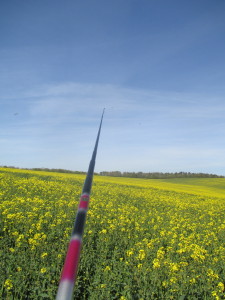
The first DCA I discovered last year showed up a sprinkling of drones today (4 May). Then it was wheat, today, it’s oil seed rape.
Spring is very slow in coming in southern England this year. The oil seed rape still isn’t in full blossom around here, but today was sunny and faintly warm so it was time to see if the drones are congregating yet.
Two of three known Drone Congregation Areas (DCAs) showed up nothing, but the third had three, maybe four, drones chasing the lure. Actually they were more interested in my hat. I’m starting to hear them before I see them. Their buzzing contrasts clearly from the many bumble bees that were around.
I am confident that these DCA locations persist from year-to-year and some obviously across the centuries.
There are no signs of queen cells in my colonies yet, but I expect that to change this weekend as the temperature rises and the nectar flows more freely.
As soon as I find a good response in known DCAs I discovered last year, I will start the search in some new areas I have in mind and put a few new ideas to the test. Since I have started eight weeks earlier this year and in time for the swarming season, I am hoping for some even more dramatic results.
In case you missed it, here’s the story from last year:
1 July 2015 In search of a mate
2 July 2015 Drone Congregation Areas
7 July 2015 Another Drone Congregation Area
20 July 2015 Video of Life in a Drone Congregation Area
28 July 2015 Do drones assemble above prehistoric sites?
3 August 2015 Drone Goal
10 August 2015 Rediscovering the first Drone Congregation Area more than two centuries later
8 September 2015 In search of a Drone Congregation Area SatNav
27 October 2015 Hilltopping
Turlough
Vita’s Guest Beekeeper Blogger

